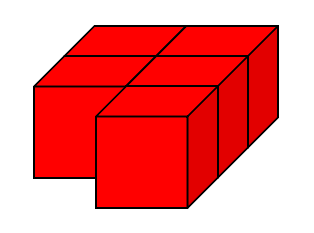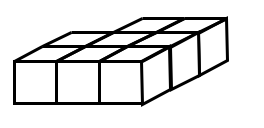Or search by topic
Number and algebra
Geometry and measure
Probability and statistics
Working mathematically
Advanced mathematics
For younger learners
Brush Loads



- Problem
- Getting Started
- Student Solutions
- Teachers' Resources
Brush Loads
We have five cubes and we're going to join them together, following a few simple rules:
- the cubes must be together face-to-face;
- they must not topple over.
We're going to paint the faces that can be seen. One Brush Load (a kind of unit that we'll use) will paint one square face.
For example, here are five cubes joined together:

Counting the faces to be painted comes to 15, so 15 Brush Loads (or BLs) are needed. Remember we're only counting visible faces, so not those that are touching the surface where the cubes are placed.
But of course we could have placed the five cubes differently, for example:

Counting the faces to be painted now, we have 17, so 17 BLs.
Can you find ways of arranging five cubes so that:
- you need as few BLs as possible?
- you need as many BLs as possible?
Can you find arrangements that need all the numbers between the largest and the smallest numbers of BLs?
What happens if you use more cubes, for example 6, 7, 8...?
Can you find out the smallest number of BLs and the largest number of BLs possible in each case?
Can you predict the arrangements which need as few BLs as possible and as many BLs as possible?
Why do this problem?
This activity is very practical, and encourages visualisation, as well as helping to develop concepts associated with area, particularly surface area. By creating lots of different arrangements of the five cubes, learners will get a feel for ways in which to increase/decrease the surface area and therefore the number of 'Brush Loads'. They can then make conjectures about the largest and smallest possible totals for a different number of cubes, building up to a proof which predicts the results for any number of cubes.
This investigation that can be extended very far indeed, and some pupils may succeed beyond your expectations!
Possible approach
It is worthwhile for pupils to work in pairs or threes and to have cubes in front of them so as to enable productive discussions to take place. As they create different arrangements and work out the number of BLs, listen out for different ways of working and emergent thinking about how to make the number of BLs as large/small as possible. Learners are usually able to articulate that keeping shapes flat produces smaller numbers of BLs and making the tallest towers produces the largest, but challenge them to explain why this is the case. Look out for children moving one cube about from one place to another - you can get into good quality conversations about how many square faces are being covered by the new position and how many new square faces are added.

... they might count "3 plus 3 plus 3 plus 3 plus 8". It then becomes very interesting that with nine cubes there will also be 4 threes but adding 9 at the end. Moving to ten cubes it would be 3 + 4 + 3 + 4 + 10. The discussions can go on and on as pupils' confidence grows.
Key questions
How are you counting the faces?
Are you able to make a shape with more/fewer faces?
Can you explain why or why not?
Possible support
Ensuring that all learners have a supply of cubes and encouraging them to discuss what they are doing will help everyone access this task.
Possible extension
Some learners may move on to tabulating their results. You might want to introduce standard units (cm$^2$) with older children. If you use multilink, 1BL might be equivalent to 4 cm$^2$. Here is a screenshot of a spreadsheet of some findings related to this investigation that you may find useful. But, please don't just hand it out to the children!
You might like to read the article Back to the Practical? which discusses this problem as an example.
Related Collections
You may also like
The Big Cheese
Investigate the area of 'slices' cut off this cube of cheese. What would happen if you had different-sized block of cheese to start with?
Wrapping Presents
Choose a box and work out the smallest rectangle of paper needed to wrap it so that it is completely covered.

